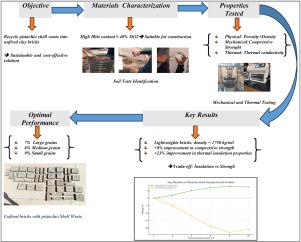Characterization of the physicochemical and functional properties of clay-based construction materials with a neutral carbon footprint using recycled pistachio shell waste
IF 6.5
Q2 ENGINEERING, ENVIRONMENTAL
引用次数: 0
Abstract
This study explores the recycling of pistachio shell waste in producing eco-friendly, non-fired clay bricks, aiming for both economic and ecological benefits. The pistachio shells were sourced from the Taounate region in northern Morocco, and the clay used was extracted from Oulad Azam, in the same region. X-ray analysis of the soil revealed a high Illite clay content with around 40 % SiO2, making it suitable for construction. Brick samples were made with varying pistachio shell content (0 %–20 %, including intermediate levels such as 1 %, 3 %, 5 %, 7 %, and 15 %) and sizes: small (δ < 1 mm), medium (1 mm < δ ≤ 3 mm), and large (δ > 6 mm). Physical (porosity, density), mechanical (compressive strength), and thermal (conductivity) properties were evaluated. Results showed lightweight bricks, with densities below 1.75 g/cm3, linked to higher porosity for smaller additive sizes. Microscopic observations confirmed reduced porosity for finer additive sizes (δ ≤ 1 mm), contributing to enhanced performance. Compressive strength improved by 8 % and thermal conductivity by 23 % with smaller grains. The strength of the bricks generally decreased with increasing additive content, while insulation improved significantly. However, there was a trade-off between insulation and strength. The optimal balance was found at additive dosages of 7 %, 8 %, and 9 % for large, medium, and small grains, respectively, yielding bricks with better performance than conventional industrial ones. These results suggest that the valorization of local agricultural waste contributes positively to both sustainable construction and the local economy.

利用回收的开心果壳废弃物制备中性碳足迹粘土基建筑材料的理化特性和功能特性
本研究探索利用开心果壳废弃物生产环保、免烧制粘土砖,以达到经济效益和生态效益并重的目的。开心果壳来自摩洛哥北部的陶纳特地区,所使用的粘土来自同一地区的奥拉德阿扎姆。对土壤的x射线分析显示,伊利石粘土含量高,SiO2含量约为40%,适合建筑。砖样由不同的开心果壳含量(0% - 20%,包括中间水平,如1%,3%,5%,7%和15%)和尺寸制成:小(δ <;1毫米),中(1毫米<;δ≤3mm),且较大(δ >;6毫米)。评估了物理(孔隙度、密度)、机械(抗压强度)和热(导电性)性能。结果表明,轻质砖的密度低于1.75 g/cm3,添加剂尺寸越小,孔隙率越高。微观观察证实,更细的添加剂尺寸(δ≤1 mm)降低了孔隙率,有助于提高性能。晶粒越小,抗压强度提高8%,导热系数提高23%。随着添加剂含量的增加,砖的强度普遍降低,而保温性能明显提高。然而,在绝缘和强度之间有一个权衡。大、中、小颗粒砖在添加量分别为7%、8%和9%时达到最佳平衡,生产出的砖性能优于常规工业砖。这些结果表明,当地农业废弃物的增值对可持续建筑和当地经济都有积极的贡献。
本文章由计算机程序翻译,如有差异,请以英文原文为准。
求助全文
约1分钟内获得全文
求助全文
来源期刊

Cleaner Engineering and Technology
Engineering-Engineering (miscellaneous)
CiteScore
9.80
自引率
0.00%
发文量
218
审稿时长
21 weeks
 求助内容:
求助内容: 应助结果提醒方式:
应助结果提醒方式:


